You have probably heard that before starting the hot water heating system, after installing or repairing it, it is necessary to pressurize it. Therefore, many are interested in when the heating system must be pressurized, what it is, by whom and how it is carried out, depending on the type and number of storeys of the house. In this article, we will try to provide answers to these questions.
Pressure testing of a heating system is a hydraulic (or pneumatic) test of its elements to determine their tightness and ability to withstand the design working pressure of the coolant during operation, including water hammer. This is necessary in order to identify possible leaks, its strength, installation quality and to ensure reliable operation of the system throughout the entire heating season.
When should it be done?
Pressure testing or hydraulic (using water), and sometimes pneumatic (using compressed air) tests of heating systems are carried out in the following cases:
- In new, just assembled - after the completion of installation work and putting it into operation;
- In those that have already been operated:
- after completion of the repair or replacement of any of its elements;
- in preparation for each heating season;
- in apartment buildings also at the end of the heating season.
Who should carry out the crimping
In multi-apartment residential buildings, industrial or administrative buildings, pressure testing of heating systems must be carried out by certified specialists of the services responsible for their operation and maintenance. In private houses, with autonomous heating, this work can be done either by specialists or independently (most often, in cases where the heating system in the house was assembled by hand). In any case, the requirements (by method, maximum pressure, time) and regulatory rules for conducting such tests, which are regulated in SNiP according to this kind works.
How is crimping carried out
The procedure for crimping heating system largely depends on the type and number of storeys of the building (a large multi-storey building or a small a private house), its complexity (the number of circuits, branches, risers), wiring diagrams, material and wall thickness of its elements (pipes, radiators, fittings), etc. Most often, such tests are hydraulic, that is, they are carried out by pumping water into the system , but can also be pneumatic when excessive air pressure is created in it. But hydraulic tests are carried out much more often. Therefore, we will first consider this option.
Pressure testing in an apartment building
As already mentioned, in such buildings, pressure testing of the water heating system is performed by special services, after installation and before commissioning, after repair, before the start of each heating season and after it, using special equipment. Based on the results of such tests, as a rule, a crimping certificate is drawn up, of the appropriate form.
Pressure testing of the heating system of an apartment building
Before carrying out hydraulic tests, preparatory work is performed:
- Visual inspection of the condition of the elevator (supply unit), main pipes, risers and all other elements of the heating system;
- Checking the presence and integrity of thermal insulation on heating lines.
If the system has been in operation for more than 5 years, it is advisable to flush it before pressure testing. For this, the coolant present in it is drained and it is washed with a special solution. Then you can proceed to hydraulic tests.
The sequence of work during hydraulic pressure testing is as follows:
- The system is filled with water (if it is just installed or it was flushed);
- With the help of a special electric or manual pump, excess pressure is created in it;
- The pressure gauge controls whether the pressure is maintained or not (within 15-30 minutes);
- If the pressure holds (the pressure gauge readings do not change), then the tightness is ensured, there are no leaks and all its elements withstand the pressure test;
- If a pressure drop is recorded, all elements (pipes, connections, radiators, additional equipment) are checked for water leakage;
- After the location of the leak is determined, it is sealed or the element is replaced (pipe section, connecting fitting, shutoff valves, radiator, etc.) and the hydraulic tests are repeated.
What should be the crimping pressure?
The fluid pressure that is created during hydraulic tests of heating systems depends on the operating pressure in them, which, in turn, depends on the material of its pipes and radiators that were used during their installation. For new systems, the crimping pressure should exceed the operating pressure by 2 times, and for existing systems, it should be exceeded by 20-50%.
Each type of pipes and radiators is designed for a certain maximum pressure... Taking this into account, the maximum working pressure in the system is selected and it must be taken into account when choosing the crimping pressure. So, for example, in apartment buildings with cast-iron radiators, the working pressure, as a rule, does not exceed 5 atm. (bar) and is usually within 3 atm. (bar). Therefore, as a rule, pressure testing of such systems is performed with a pressure of no more than 6 atm. Systems with convector-type radiators (steel, bimetallic) can be pressurized even at higher pressures (up to 10 atm).
Pressure testing of the input unit is carried out separately, at a pressure of at least 10 atm. (1 MPa). To create this pressure, special electric pumps are used. The tests are considered successful if the pressure drop within 30 minutes is no more than 0.1 atm.
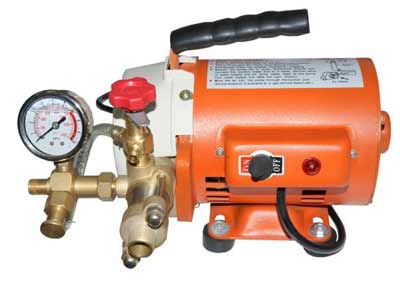
Electric pump for pressure testing the heating system
Crimping in a private house
In autonomous closed water heating systems of private houses, the operating pressure rarely exceeds 2.0 atm. (0.2 MPa) and, as a rule, is in the range of 1.5 atm. Therefore, to create pressure (1.8-4 atm.) In such a system, you can use both electric and manual pumps, or connect it to the water supply system of the house (usually the water pressure in it is 2-3 atm., Which is quite sufficient for hydraulic tests).
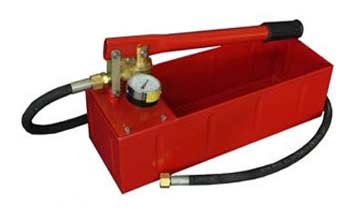
Hand pump for pressure testing the heating system
Filling the system with water must be carried out from below through a drain or a specially designed tap. In this case, the air will be easily pushed out of it by the liquid coming from the bottom upwards and removed through the air valves, which should be installed at its highest point, in places of possible formation of air locks, as well as on each radiator.
It should also be remembered that the temperature of the water used for testing should not be higher than 45 ° C.
If the system is simple enough, and besides, it was assembled by hand, then its crimping can be done independently, performing the work in the same sequence as in an apartment building.
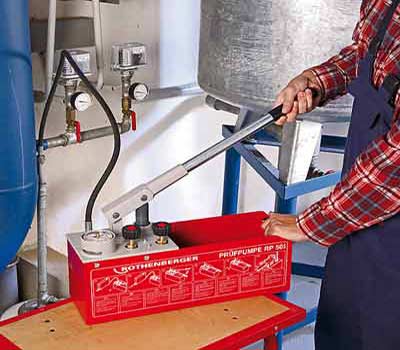
Pressing the heating system with a hand pump
In the event that, after pressure testing, the injected water will be used in the future as a heat carrier, then it is necessary that it be "soft", that is, it has a hardness of no more than 75-95 units (mainly, this is the presence of magnesium and calcium salts) ... An example of "soft" water can be rain or melt water, from snow or ice. If there is no certainty about the hardness of the water, and an indicator of its increased hardness may be the formation of scale in an electric kettle, heating elements of a washing machine or boiler, then it is better to do an analysis in a laboratory.
In the same case, if the water used for hydraulic tests will not be used as a heat carrier, then after pressure testing it should be drained and the system should be immediately filled with a suitable heat carrier. This is especially important if pipes made of black steel were used for wiring, and cast iron or steel pipes were used as radiators without protecting their inner surface.
Features of air pressure testing
Air pressure testing is used less often, as a rule, for small buildings, private houses, if hydraulic tests cannot be carried out for some reason. For example, if it is necessary to check the tightness of the installed system, but there is no water or equipment for pumping it.
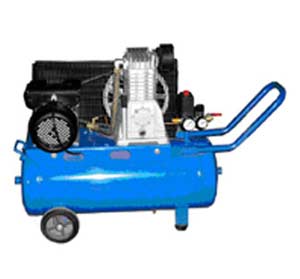
Compressor for pressure testing of the heating system
In this case, an electric air compressor or a mechanical (foot, hand) pump with a pressure gauge is connected to the make-up or drain valve, and with the help of it, an excess air pressure is created in it. It should not exceed 1.5 atm. (bar), because at higher pressure, in the event of leakage of the connection or rupture of the pipe, injury to the people conducting the tests may occur. Plugs must be installed instead of air valves.
Pneumatic tests take longer to pressurize the system. Since, unlike a liquid, air is compressed, it takes more time to stabilize and equalize the pressure in the circuit. Initially, the gauge may slowly drop even if it is sealed. And only after the air pressure has stabilized, it is necessary to withstand it for at least 30 minutes.
Pressure testing of open heating systems
In order to carry out pressure testing of an open heating system, it is necessary to seal the connection point of the open expansion tank, for example, using a ball valve installed on the pipe supplying water to it. When pumping water, it can be used as an air valve, and after it is filled, before creating excess pressure, the valve must be closed.
The operating pressure in such systems, as a rule, is determined by the height of the expansion tank, based on the calculation, for every 1 m of its excess above the level of the return flow to the boiler, there is 0.1 atm of excess pressure in this place. In one-story houses, an open expansion tank is usually located under the ceiling or in the attic. The water column in this case will be 2-3 m high, and the excess pressure, respectively, will be 0.2-0.3 atm. (bar). When the boiler room is located in a basement or in two-story houses, the difference between the level of the expansion tank and the boiler return can be 5-8 m (0.5-0.8 bar, respectively). Consequently, in this case, a lower overpressure of the liquid (0.3 - 1.6 bar) is required to carry out hydraulic tests.
Otherwise, the procedure for pressure testing of open systems (one-pipe and two-pipe) is the same as for closed systems.
Related Videos
Hydraulic test. After completion of the installation of the heating system, it is subjected to a liquid filling and a hydraulic test. The heating system is filled through the return pipe (from bottom to top). In this case, liquid and air move in the same direction, which helps to remove air from the system through air vents, expansion tanks or plungers.
With the gradual filling of the heating system, the liquid evenly rises upwards, due to which the liquid level in the vertical pipelines and heating devices is in the same plane, this contributes to the displacement of air from the heating system. In the case of a rapid filling of the heating system, risers can be filled faster than heating devices, as a result of which "air pockets" can form.
Water heating systems are being tested hydraulic pressure, in this case, the pressure during the test should exceed the operating pressure by 100 kilo Pascal and at the lowest point should not be lower than 300 kilo Pascal. The hydrostatic test is carried out with the boiler and expansion vessel switched off.
IN winter time year system central heating, which is made by the open laying of risers, is not subjected to a hydraulic test. Also, if the system has worked satisfactorily for about three months, it can be accepted without a hydraulic test.
In the case of laying pipelines of a heating system of a hidden type, hydraulic tests are carried out before closing the furrows, and in the case of insulated pipes before applying insulation to them. During the hydraulic test of the heating system, it is necessary to use only proven pressure gauges, the scale of which is 10 kilo Pascal. Work on testing the heating system must be carried out using a powered or manual hydraulic press, before painting.
In the case of testing steam heating systems with an operating pressure of up to 70 kilo Pascal, the test is carried out at a pressure of 250 kilo Pascal at the lowest point of the heating system. When checking steam heating systems, the operating pressure of which exceeds the value of 70 kilo Pascal, the tests are carried out at a pressure that is 100 kilo Pascal higher than the operating pressure, but not lower than the value of 300 kilo Pascal at the top point of the heating system.
It is considered that the steam or water heating system has passed the test if within 5 minutes the set pressure in the system does not fall by more than 20 kilo Pascal.
After completing the hydraulic test of the steam heating system, it is checked for tightness of the connections by letting steam into the system, which has a working pressure. In this case, steam leakage from the heating system is not allowed.
After completing the tests, the heating system is flushed, for which a coupling or tee is installed at its lowest point, the cross section of which is at least 60-80 mm2, through which the water is drained. The heating system is flushed cold water several times until its maximum clarification. The panel heating system is subjected to a hydraulic test with a pressure of 1000 kilo Pascal for 15 minutes, before the stage of sealing the mounting windows, in this case a pressure drop is allowed, but not higher than a value of 10 kilo Pascal. In case of negative temperatures environment allowed to conduct pneumatic tests these systems. After the completion of the hydraulic test, for 7 hours, thermal test heating systems. If the ambient temperature is positive, then the temperature of the liquid that is supplied to the line must be at least 60 ° С, and at negative temperatures not lower than 50 ° С.
Pneumatic test of the heating system.
Pneumatic testing of the heating system is allowed if the ambient temperature is below 5 ° C.
When carrying out a pneumatic test of system components and pipelines under a pressure of 100 kilo Pascal, it is not allowed that the pressure drops by more than 10 kilo Pascal within five minutes.
When testing the heating or water supply system, as well as their units, pressure gauges are used that have an accuracy class of 2.5 and a division price of no more than 5 kilo Pascal.
Ground and above ground pipelines, which are assembled from polymeric materials, are subject to pneumatic testing in the following cases:
- for technical reasons, the use of liquid is unacceptable;
- ambient temperature below 0 ° С;
- there is no liquid in the volume that is necessary for the test.
If the pipeline is made of polymeric materials, then the course of pneumatic testing of pipelines and the requirements for their safety are established exclusively by the project.
This is due to the fact that the technology of pneumatic testing of pipelines made of polymer materials is not regulated.
Due to the fact that during pneumatic pressure testing it is difficult to find the place of leakage (defect), hydraulic pressure testing is more convenient.
Thermal testing of the heating system is carried out to determine the uniformity of heating heating equipment.
To carry out a thermal test, it is necessary that the temperature of the liquid in the supply pipeline is at least 60 ° C.
In the case of negative ambient temperatures, a thermal test of the heating system is carried out according to the corresponding temperature schedule.
The thermal test of the heating system lasts about 7 hours, at this time the uniformity of heating of the heating equipment (batteries, radiators) is checked and, if necessary, adjustment is carried out.
Commercial metering of heat and energy consumption is carried out in order to carry out financial calculations of heat-consuming organizations with heat supply organizations in accordance with the actual heat load based on the readings of a heat meter - a metering device for heat energy consumption. In the absence of commercial metering of heat and energy consumption, its payment is carried out in accordance with the calculated loads. In the case of installing a metering unit (heat meters), the costs associated with heat supply are reduced by 25-40 percent.
The organization of a commercial metering unit for heat energy makes it possible to register and record the consumption and supply of heat energy, it also provides:
- more expedient use of heat carrier and heat-energy;
- registration of emergency situations during the operation of the heat supply system;
- a fairly high accuracy of the volume of consumed heat and the flow rate of the heat carrier, as well as the possibility of making monetary settlements between consumers of heat energy and heat supplying enterprises;
- documenting the parameters of the coolant: its mass, pressure and temperature;
- control over the hydraulic and thermal modes of operation of the system, both heat consumption and heat supply;
- various operating conveniences during operation;
- combining various nodes into a single network (data transfer is carried out via RS 232 and RS 485).
A heat meter is a set of devices that account for the indicators of consumed heat and energy and coolant in water heat supply systems, namely:
- temperature difference in pipelines, ° С;
- thermal power;
- coolant consumption in the pipeline, cubic meters per hour (tons per hour);
- total level of consumed heat energy (cumulative total);
- coolant temperature, ° С, both in the supply and return pipelines;
- the total mass (tons) and volume (cubic meters) of the coolant that flows through the pipeline (cumulative total);
- daily and hourly average values of all of the above parameters.
Heat meter installation diagram:
1 - supply pipeline; 2 - shut-off valves; 3 - return pipeline; 4- hot water meter; 5- resistance thermocouple.
A heat meter consists of the following elements: a calculator for the amount of heat, a primary transducer of the coolant flow rate, a thermal resistance transducer, an overpressure transducer, a power supply unit for sensors and flow meters (if necessary).
Most widespread in the market Russian Federation received composite heat meters, which are equipped with the following flow meters:
- mechanical- equipped with a heat calculator and mechanical rotary or vane water meters (flow meter). It is the cheapest option for a heat meter, at the same time it should be noted that the cost of special filters must be added to their cost, which must be installed in front of each flow meter;
- vortex- equipped with a heat calculator and a vortex flow meter, quite often their own power supply is required. The peculiarity of a vortex flowmeter is a metal prism that is installed across the flowmeter pipe, therefore, it is necessary to install filters in front of each flowmeter, these filters quite often clog and break, therefore, heat meters equipped with this flowmeter are subject to constant maintenance.
During the passage of the fluid flow, vortices are created on the edges of the prism, the number of which is directly proportional to the flow velocity. Vortices are captured by the electromagnetic method (for example, the Sayany or VEPS flow meters) or using ultrasound (for example, the Maklo or Metran flow meters);
- ultrasonic- these flow meters are widely used in European countries, since they use pipelines with an enamel coating inside and very clean water circulates through them. In the conditions of the post-Soviet countries, it is possible to use ultrasonic flow meters only if pre-filters are installed, this is due to the fact that there are protruding parts and rather difficult turns inside the flow meter pipe, on which scale quickly forms and dirt accumulates.As practice shows, about 30-40 percent of ultrasonic flow meters installed in Russian heating systems fail in the first two to three years of operation, the main cause of breakdown is scale and dirt;
- electromagnetic flow meters are optimally adapted to work in the Russian heating system. There are no protruding parts in the flow meter pipe; there is no need for additional filters for them. As a result, these flowmeters provide almost zero pressure drop. It should be noted that the deposition of oil products or scale on the pipe walls of this flow meter practically does not affect its performance.Also, certain types of electromagnetic flowmeters (for example, "Magika", KM-5 and SA-94) withstand quite well the changes associated with the saturation of water with scale, rust and other types of solid impurities. These heat meters are capable of measuring the return flow of liquid in open heat supply systems, which is quite common in the post-Soviet space. Moreover, such models as "Magika" and KM-5 can automatically control the direction of fluid flow in the pipeline, in the absence of water in the system, they will automatically turn off.
Important! Operation of electromagnetic meters is not allowed in the absence of liquid in the pipeline.
The disadvantages of electromagnetic meters (in comparison with other types) include the fact that these devices cannot operate for a long period from an autonomous power source.
Composite heat meters equipped with electromagnetic flow meters consist of the following elements: one or more electromagnetic flow meters (KM-5, VKT + PREM, Vzlet TCP, SPT + PREM, etc.) and a heat calculator.
The constituent parts of the electromagnetic heat meter have their own metrological certificates, and the manufacturer of this meter also issues a metrological passport for the entire set of the heat meter.
The composition of the electromagnetic heat meter includes an electrical unit containing itself and a heat calculator ("Magika", SA-94, "Katra", TEM-05, "Thermik", VIST, etc.) and the electronics of a one- or two-channel flow meter. Electromagnetic flow converters of these heat meters are calibrated together with the electrical unit, so they do not have their own electronic components.
How to carry out a hydraulic test of a heating system without involving specialists? The accumulated experience allows me to assert that in private houses this can be done independently. And as a bonus, I will tell you in detail how this is done in two versions and what is needed for this.
A bit of theory
According to the rules, pressure testing can be carried out at temperatures from +5 ºС to +40 ºС. Compliance with these standards is especially important when testing with water:
- High-rise buildings with centralized heating should be checked after the end of each heating season, that is, in the spring, this is due to the fact that all defects can be eliminated over the summer;
- In private houses, it is not necessary to check the system so often; here one pressure test is enough before the first start-up or after replacing important components of the heating system.
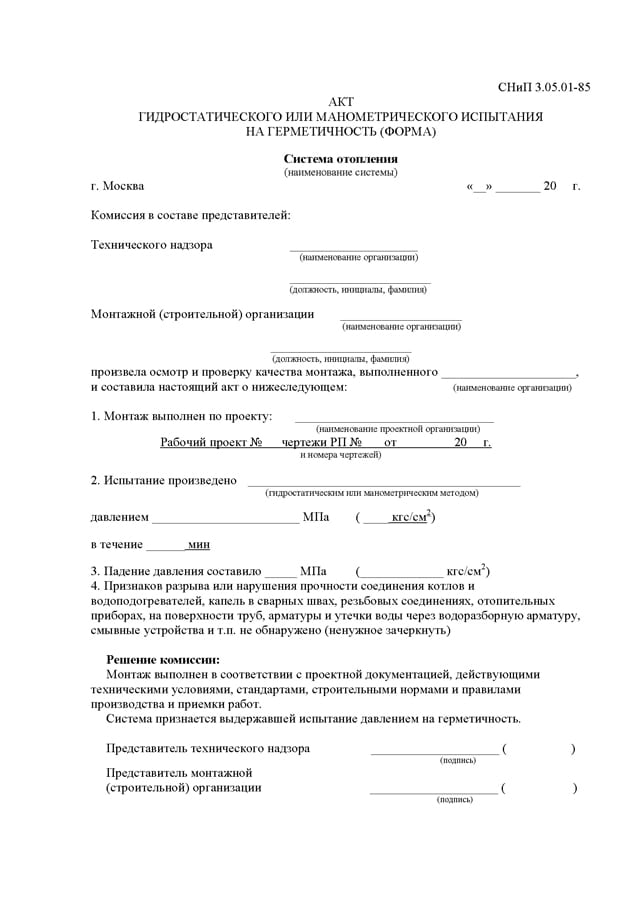
General order of work:
- The system is disconnected from the supply and the coolant is drained;
- If there are heating boilers and control equipment in the system, then they are disconnected or isolated;
- Clean water with a temperature of up to 45 ºС is pumped into the system;
- The equipment is connected to the supply and pressure is built up. To avoid water hammer, the pressure rises gradually;
- The system must withstand at least 10 minutes of increased pressure.
The practical side of the issue
Pressure testing of the heating system can be carried out with air and water, each option is good in its own way.
Option number 1. Pneumatic pressure testing
It is believed that pressing the heating system with air is not a sufficiently reliable way, but I have repeatedly checked it and I can say with confidence that it is suitable for an average private house of 2 floors.
By the way, you can find the norms and rules for hydraulic testing of the heating system in SNiP 41-01-2003, SNiP 3.05.01-85, and there is also "Rules for the technical operation of thermal power plants" under number 115.

The main advantages of the pneumatic version, I would call simplicity, almost zero cost and safety. After all, if the house is not residential, and you do not plan to enter it yet, then it is dangerous to fill in water, since even a slight frost can break the pipes, and you do not risk anything with air.
| Illustrations | Recommendations |
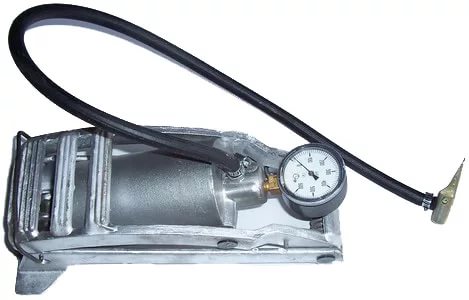 | Instruments.
|
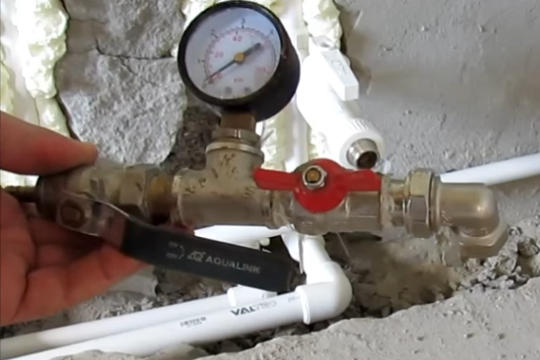 | Gadgets. To connect the pump to the system and control the pressure, you need to assemble the structure shown on the left in the photo, this includes (from left to right):
|
 | System connection. We will connect our device to the outlet designed to drain the water. But first we need:
|
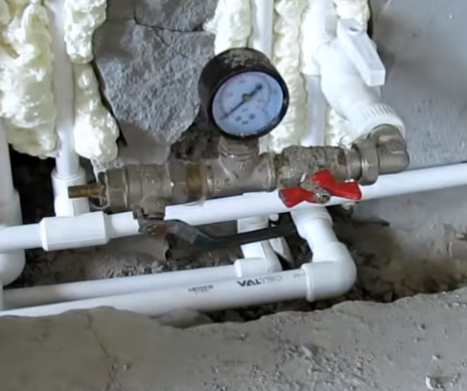 | We fasten the adapter assembly with a pressure gauge. |
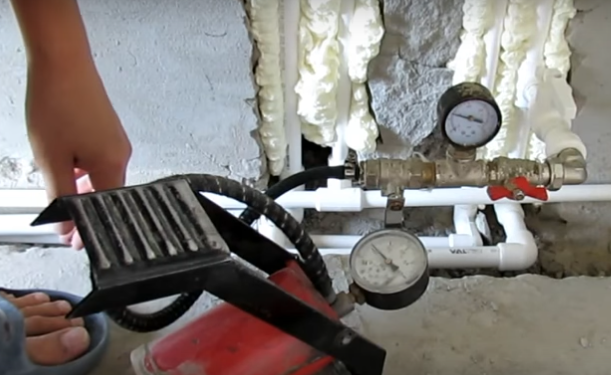 | Build up pressure. Now we need to remove the car adapter from the pump hose, connect this hose to the fitting and tighten the clamp with a screwdriver. |
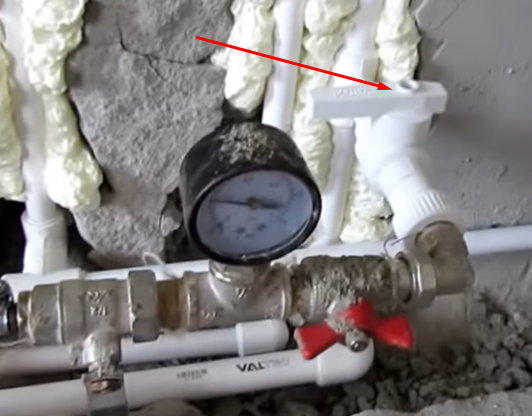 | Controlling pressure. When the system has become pressurized, the first valve of our unit with a pressure gauge can be closed and the pump disconnected. After about half an hour, if the pressure persists, turn off the tap on the drain pipe and leave it there for a day. The next day, the pressure may drop a little or, on the contrary, rise (within half an atmosphere), do not be alarmed, this is due to temperature changes. Air, compared to water, is much more fluid and with the slightest damage, the pressure will drop in a few minutes.
|
Under air pressure, the heating system can stand indefinitely, moreover, while finishing work is going on in the house, it is better not to dump the air, so if the pipe is damaged, for example, when installing the plinth, you will immediately find the problem (the air will hiss).
Option number 2. Pressing underfloor heating
Carrying out hydraulic tests of a heating system in which there is a warm floor is slightly different from the above option. In a private house, such work can be done by hand, but a highly specialized tool is needed, plus the instructions are more complicated here.
| Illustrations | Recommendations |
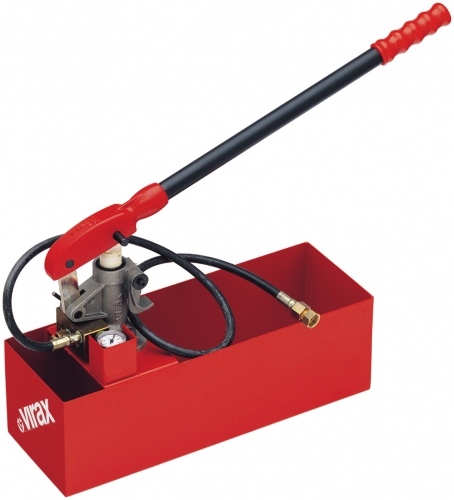 | Instruments. Hydraulic tests of the underfloor heating system are supposed to be carried out with water, and to build up pressure, you will need a "Hydraulic Pressure Operator", a manual apparatus with a capacity of 12 liters is enough. There is no point in buying such a device for a one-time job, and its price is decent, so it is easier to rent, you need it literally for a couple of hours. |
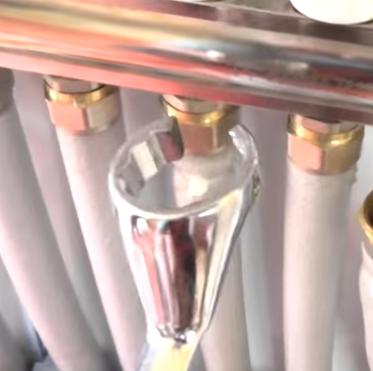 | Split wrench, with it you will pull the connections on the combs. |
 | Pouring system. First, we need to complete the system. To do this, we connect a pressure gauge with two ball valves to the input, as in the photo, and on the return line we simply put a ball valve and turn on the water supply. |
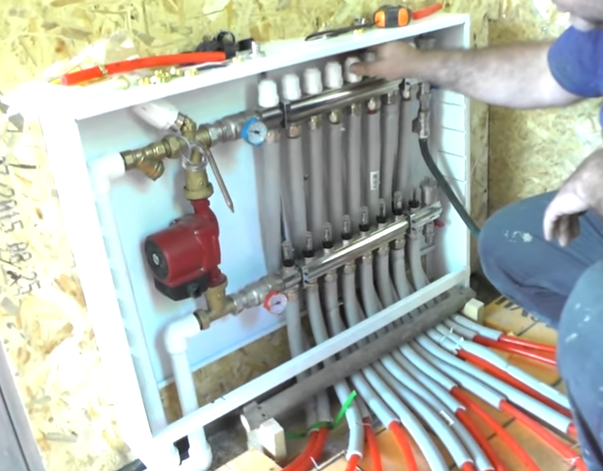 | System check. For the underfloor heating system, a distribution cabinet is mounted, in which there are 2 combs, supply and return, as well as a pump and a number of valves to adjust the operation.
|
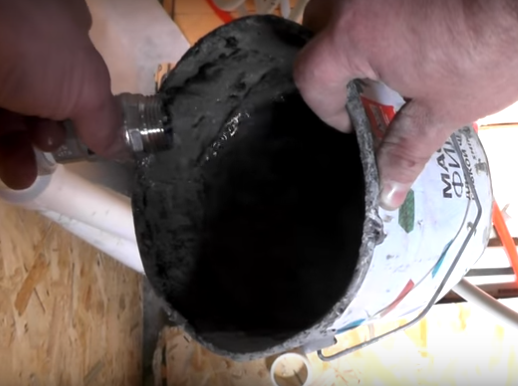 |
|
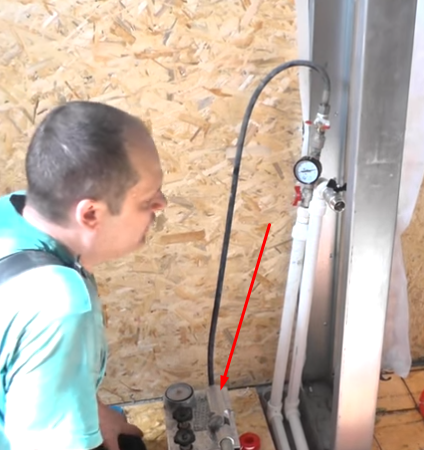 | We check the reliability of the switch cabinet components.
|
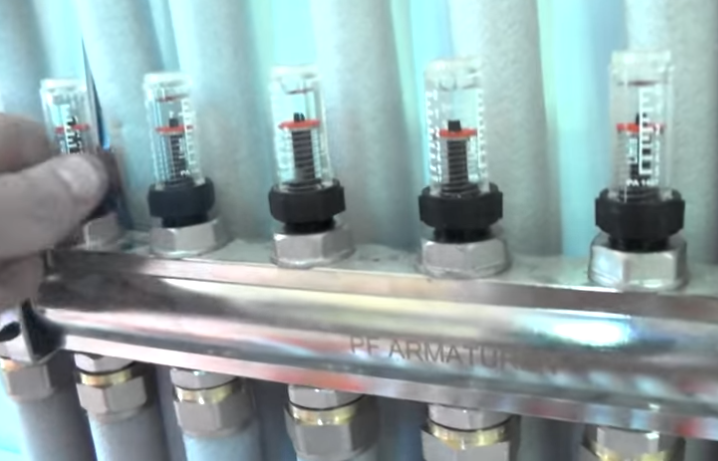 | Checking the operation of the system. If the working pressure is exceeded three times, after half an hour you will see defects, if any. After half an hour, I turn on the pump and the system works for another half hour. Then you can release the pressure to the working one and fill the screed. |
Output
Now you know how the hydraulic check of the heating system is carried out. The video in this article has additional information on the topic. If you have any questions, write in the comments, I will try to help.






